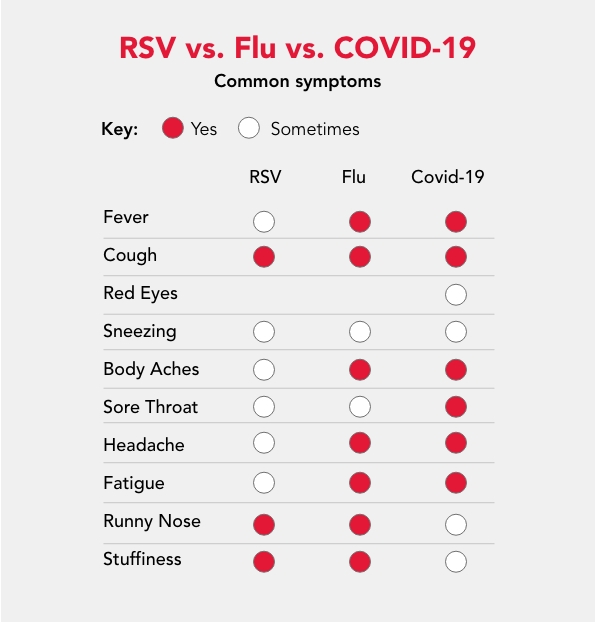
Published February 2023
When the weather is colder and dryer, and people spend more time indoors, viruses tend to spread more easily. This season, experts report we’re at risk for a tripledemic, with the flu, COVID-19 and respiratory syncytial virus (RSV) all spreading simultaneously. And although these viruses are not peaking at the same time, all three are currently being reported.
Why is RSV a concern in addition to the flu and COVID-19 this year, what does this mean for your loved ones’ health and how can you keep the whole family healthy in the coming months? Let’s find out.
Learn More >> Explore Well-Being Programs
What's RSV and why are we hearing about it now?
While it may seem like respiratory syncytial virus (RSV) is becoming a household term for the first time this year, it’s not actually new. It’s a common respiratory virus that typically causes cold-like symptoms from which most people only become mildly ill and recover in two weeks or less. Nearly all children will contract RSV by the age of two. However, RSV may become dangerous for those with weakened immune systems, like infants and elderly adults, who can develop serious airway and lung infections like bronchiolitis (an inflammation of the small airways in the lungs) and pneumonia.
Why did RSV, flu and COVID-19 become a triple threat?
What’s new this year is the drastic and unusually early spike in RSV-associated emergency department visits and hospitalizations across the country. Although there is a preventative monoclonal antibody available to preterm babies who are at higher risk, doctors are seeing increased cases before dosing would normally even begin. This earlier and higher prevalence of RSV, combined with increased flu and COVID-19 cases, mean care could be impacted by a national shortage of health care workers, leading to an overwhelmed health care system. This makes taking precautions to prevent the spread of these contagious viruses critical.
What are the symptoms of each of these viruses?
The symptoms of RSV, flu and COVID-19 are similar, so it can be difficult to know what’s what. Although everyone’s body may act a little differently, there are some typical symptoms that come with each virus. Here’s a graphic to help you navigate your illness.

Learn More >> Log into the Member Portal for Resources and Support
How can you protect against RSV, the flu and COVID-19?
Getting vaccinated for the flu and COVID-19 is encouraged. However, there is currently no vaccine for RSV. While over-the-counter fever reducers and pain medicines for symptoms of RSV and other viruses may offer some relief, not all OTC meds are available for children under 12. In addition to talking with your doctor about what steps you can take to treat these illnesses at home, the best path is to try and avoid contraction in the first place. Consider the following tips:
- If anyone in your family is feeling ill, stay home. And avoid contact with individuals who might be sick.
- Engage in frequent handwashing (for 20 seconds) and avoid touching your face with unwashed hands.
- Clean and disinfect frequently touched surfaces like doorknobs and cell phones.
- Avoid sharing cups and eating utensils with others.
- Engage in healthy habits at home, like catching a good night’s sleep and eating a nutrient-rich diet.
It’s important to try and stay healthy any time of year, but with the earlier appearance of RSV, and its timeline colliding with flu and COVID-19, it’s now more important than ever to use best practices to reduce the risk of viral spread. And like any other illness, if you do contract one of these viruses, your doctor will always be your best resource to help you navigate your symptoms.
To confirm eligibility for any programs or services mentioned in this article as it relates to your specific health plan, please reach out to your account executive or HR benefits team. You may also speak to our member services team at (888)-333-4742 or by sending a secure email. And for plan details and other member resources, log in to the member portal.


